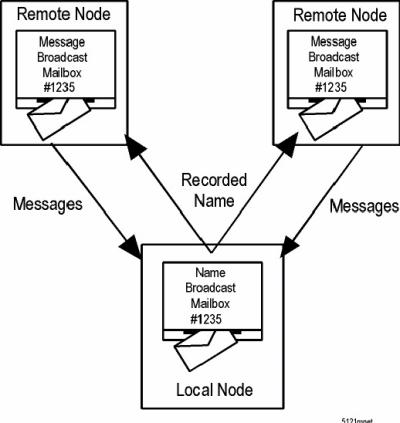Using Broadcast Mailboxes for Transparent Network Messaging
Transparent network messaging means that there is no difference to the user between sending a message to a remote mailbox and sending a message to a local mailbox. The user does not enter a network prefix when addressing a message, and the user hears the name confirmation of the mailbox owner.
You can use broadcast mailboxes to achieve this transparency. A message broadcast mailbox automatically sends any messages that it receives to the mailboxes in its first distribution list. A name broadcast mailbox automatically sends the owner’s recorded name to the mailboxes in its distribution list number 9, to be used as the recorded name for those mailboxes. You enable these features in the FCOS of the broadcast mailboxes. See Types of Mailboxes for more information about broadcast mailboxes.
For complete network transparency, every user on every node must have a mailbox on every node. A user’s mailbox on the local node has name broadcast enabled, so that the user’s recorded name is broadcast to that user’s mailboxes on all other nodes. The user’s mailboxes on remote nodes all have message broadcast enabled, so that all messages made for that user are broadcast to the local node. The diagram below shows this type of configuration:

Users always address messages to mailboxes on their local node. Because the recipient mailbox is local, the sender hears the mailbox name confirmation. If the mailbox is configured as a broadcast mailbox for a user on a remote node, the mailbox forwards the message over the network to the local node of the recipient.
Note: Broadcast mailboxes put an extra burden on system administrators. You must still configure the Digits Translation Table to provide the routing required for network messages. In addition, mailbox adds, moves and changes must be coordinated across the network, and the distribution lists in the broadcast mailboxes must be kept current. See Configuring Network Mailboxes for information about adding remote mailbox addresses to distribution lists.